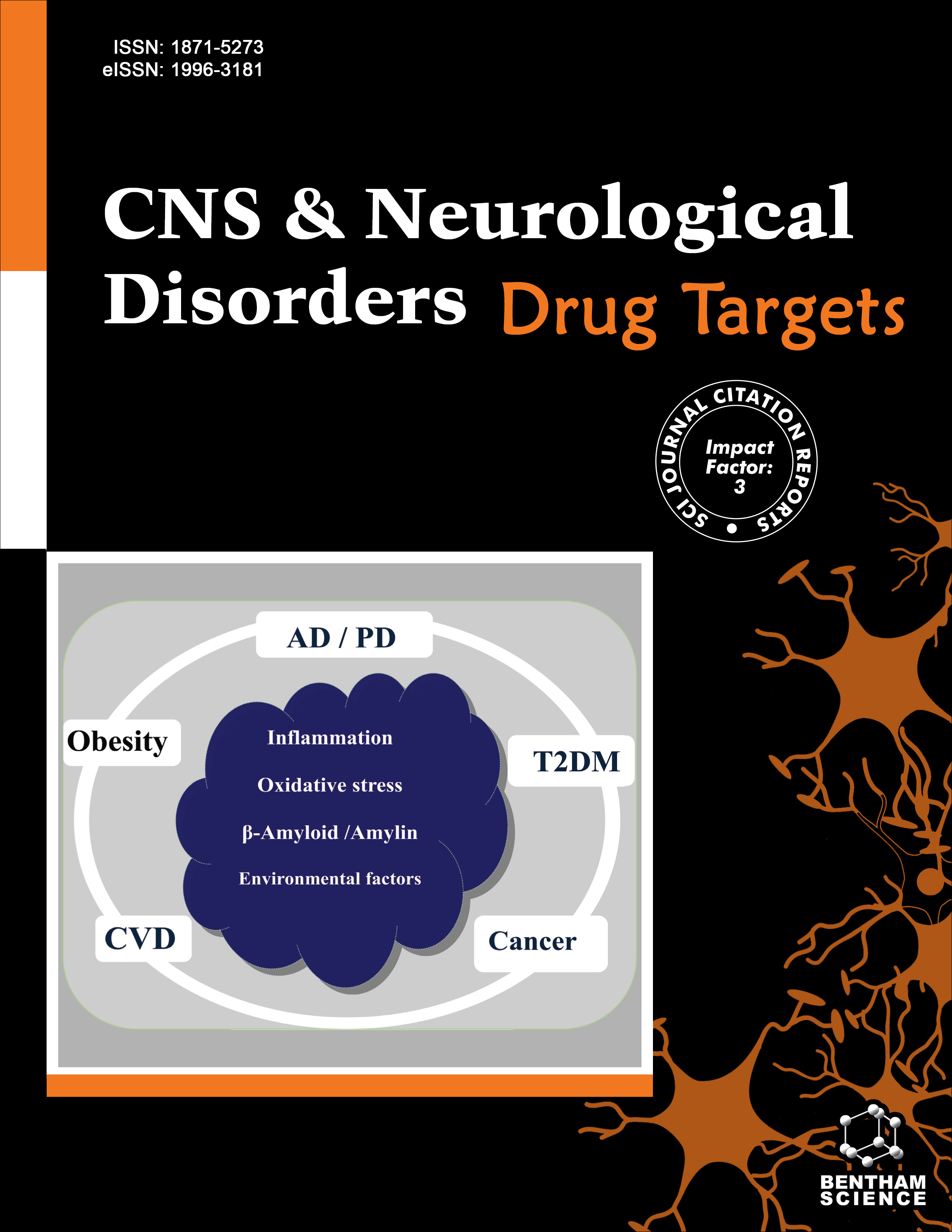- Home
- A-Z Publications
- CNS & Neurological Disorders - Drug Targets (Formerly Current Drug Targets - CNS & Neurological Disorders)
- Previous Issues
- Volume 17, Issue 5, 2018
CNS & Neurological Disorders - Drug Targets (Formerly Current Drug Targets - CNS & Neurological Disorders) - Volume 17, Issue 5, 2018
Volume 17, Issue 5, 2018
-
-
Structure, Function and Interactions of Tau: Particular Focus on Potential Drug Targets for the Treatment of Tauopathies
More LessBackground & Objective: Neurodegenrative diseases are among the most widespread lifethreatening disorders around the world in elderly ages. The common feature of a group of neurodegenerative disorders, called tauopathies, is an accumulation of microtubule associated protein tau inside the neurons. The exact mechanism underlying tauopathies is not well-understood but several factors such as traumatic brain injur Read More
-
-
-
Dl-3-n-Butylphthalide (NBP): A Promising Therapeutic Agent for Ischemic Stroke
More LessAuthors: Shan Wang, Fei Ma, Longjian Huang, Yong Zhang, Yuchen Peng, Changhong Xing, Yipu Feng, Xiaoliang Wang and Ying PengBackground and Objective: Stroke is a leading cause of morbidity and mortality in both developed and developing countries all over the world. The only drug for ischemic stroke approved by FDA is recombinant tissue plasminogen activator (rtPA). However, only 2-5% stroke patients receive rtPAs treatment due to its strict therapeutic time window. As ischemic stroke is a complex disease involving multiple mechanisms, medic Read More
-
-
-
Pain-Related Behavior and Brain Activation in a Cynomolgus Macaque Model of Postoperative Pain
More LessAuthors: Aldric Hama, Takahiro Natsume, Shin'ya Ogawa, Yuji Awaga, Ikuo Hayashi, Akihisa Matsuda and Hiroyuki TakamatsuBackground: Inadequate postoperative pain management could lead to persistent pain and this is, in part, due to incomplete understanding of the mechanism of postoperative pain. Currently available rodent models may have limited translatability to clinical postoperative pain. Thus, a preclinical model of postoperative pain was developed in the cynomolgus macaque, a species that is phylogenetically closer to humans t Read More
-
-
-
Protective Effects of Crocetin on Depression-like Behavior Induced by Immobilization in Rat
More LessAuthors: Tahereh Farkhondeh, Saeed Samarghandian, Fariborz Samini and Ali R. SanatiBackground & Objective: Crocetin, an active ingredient of saffron, has been recognized as a potent antioxidant. Plant extracts or their components may be useful in ameliorating the various diseases, including neurodegenerative disorders. This study investigated the effects of crocetin on oxidative damage induced by chronic restraint stress in the rat brain. For this reason, rats were kept in the restrainers for 1 hour every d Read More
-
-
-
Hydroxysafflor Yellow A Reprograms TLR9 Signalling Pathway in Ischaemic Cortex after Cerebral Ischaemia and Reperfusion
More LessAuthors: Zhe Gong, Jingrui Pan, Xiangpen Li, Hongxuan Wang, Lei He and Ying PengBackground and Objective: Hydroxysafflor yellow A (HSYA) was reported to suppress inflammation in ischaemic microglia. However, the mechanism through which HSYA inhibits inflammation caused by cerebral ischaemia and reperfusion injury remains unknown. Here, we have mimicked acute cerebral ischaemia and reperfusion injury by subjecting male Sprague-Dawley rats to transient middle cerebral artery occlusion for 90 Read More
-
-
-
A Longitudinal Study of Alterations of S100B, sRAGE and Fas Ligand in Association to Olanzapine Medication in a Sample of First Episode Patients with Schizophrenia
More LessBackground & Objective: Neuroinflammation has been proposed as a major mechanism in schizophrenic disorder. Specifically, an increase in the inflammatory response in the central nervous system is capable of activating microglial cells, leading to the release of pro-inflammatory cytokines and thus activating apoptotic signaling. An increase in apoptosis may underlie a potential role of immune neuropathology in the etiopath Read More
-
-
-
Oleanolic Acid Ameliorates Aβ25-35 Injection-induced Memory Deficit in Alzheimer's Disease Model Rats by Maintaining Synaptic Plasticity
More LessAuthors: Kai Wang, Weiming Sun, Linlin Zhang, Wei Guo, Jiachun Xu, Shuang Liu, Zhen Zhou and Yulian ZhangBackground: Abnormal amyloid β (Aβ) accumulation and deposition in the hippocampus is an essential process in Alzheimer's disease (AD). Objective: To investigate whether Oleanolic acid (OA) could improve memory deficit in AD model and its possible mechanism. Methods: Forty-five SD rats were randomly divided into sham operation group, model group, and OA group. AD models by injection of Aβ25-35 were built. M Read More
-
Volumes & issues
-
Volume 24 (2025)
-
Volume 23 (2024)
-
Volume 22 (2023)
-
Volume 21 (2022)
-
Volume 20 (2021)
-
Volume 19 (2020)
-
Volume 18 (2019)
-
Volume 17 (2018)
-
Volume 16 (2017)
-
Volume 15 (2016)
-
Volume 14 (2015)
-
Volume 13 (2014)
-
Volume 12 (2013)
-
Volume 11 (2012)
-
Volume 10 (2011)
-
Volume 9 (2010)
-
Volume 8 (2009)
-
Volume 7 (2008)
-
Volume 6 (2007)
-
Volume 5 (2006)
Most Read This Month
Article
content/journals/cnsnddt
Journal
10
5
false
en

Most Cited Most Cited RSS feed
-
-
A Retrospective, Multi-Center Cohort Study Evaluating the Severity- Related Effects of Cerebrolysin Treatment on Clinical Outcomes in Traumatic Brain Injury
Authors: Dafin F. Muresanu, Alexandru V. Ciurea, Radu M. Gorgan, Eva Gheorghita, Stefan I. Florian, Horatiu Stan, Alin Blaga, Nicolai Ianovici, Stefan M. Iencean, Dana Turliuc, Horia B. Davidescu, Cornel Mihalache, Felix M. Brehar, Anca . S. Mihaescu, Dinu C. Mardare, Aurelian Anghelescu, Carmen Chiparus, Magdalena Lapadat, Viorel Pruna, Dumitru Mohan, Constantin Costea, Daniel Costea, Claudiu Palade, Narcisa Bucur, Jesus Figueroa and Anton Alvarez
-
-
-
- More Less

